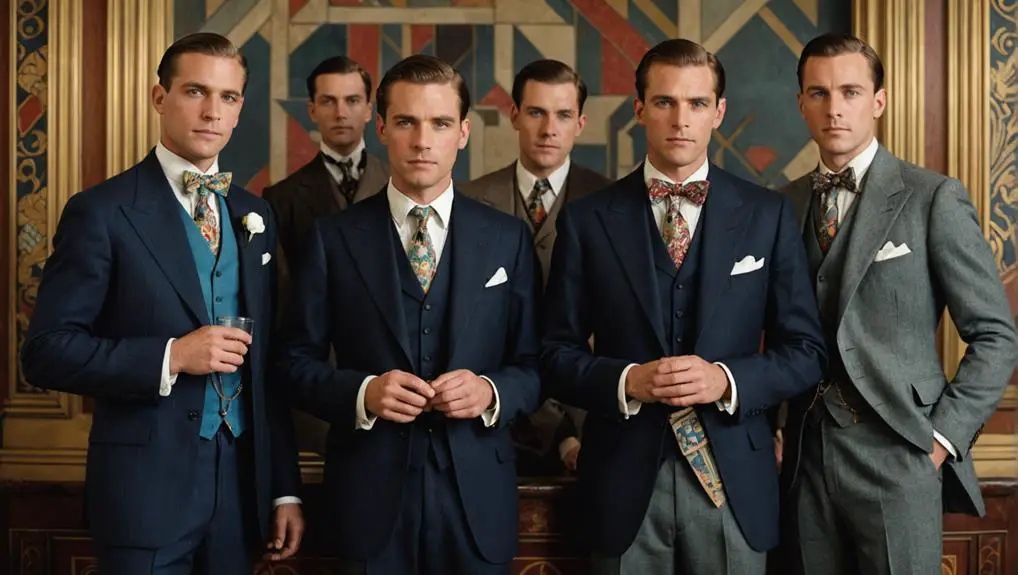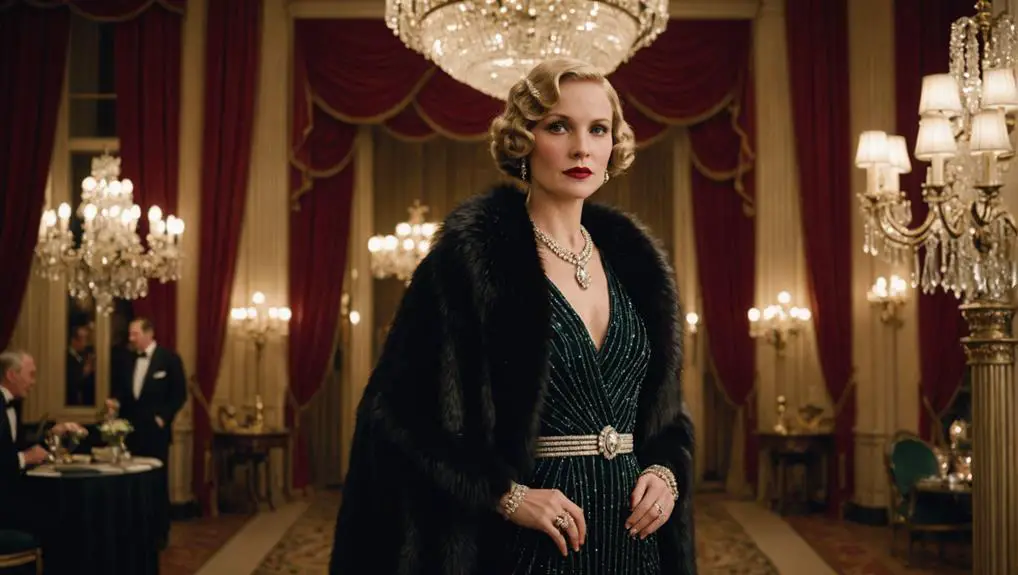In the 1920s, men's ties and bowties became symbols of sophistication and social status. You'd notice the shift from traditional bowties to longer neckties, featuring bolder, wider styles that reflect changing masculinity. Silk ties with vibrant colors and intricate patterns dominated the scene, often showcased under three-piece suits. Knot techniques, like the Four in Hand and Windsor, allowed for personalized expressions of style. Accessories, such as tie clips and pocket squares, further enhanced your look. Ties were more than just fashion; they represented cultural dynamics. There's much more to discover about this fascinating era of men's neckwear.
Evolution of Men's Ties
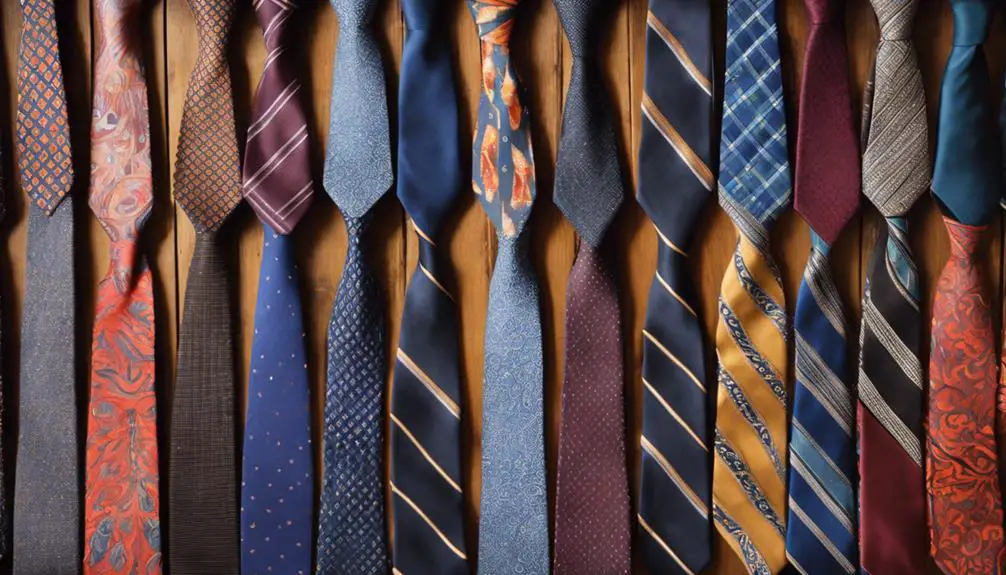
The evolution of men's ties in the 1920s showcases a remarkable shift in fashion sensibilities and social norms. During this decade, neckties surged in popularity, effectively replacing the more traditional bow ties. This change marked a newfound appreciation for longer, more versatile neckwear that could complement the stylish three-piece suit.
One of the significant advancements came in 1924 when Jesse Langsdorf introduced a design utilizing three pieces cut at a 45-degree angle. This innovation not only enhanced the durability of ties but also improved their aesthetic appeal. As the decade progressed, you'd notice the width of ties expanding from 2 inches to a fashionable 3-3.5 inches, allowing for bolder style statements.
Silk ties became a staple, showcasing vibrant colors and intricate patterns like stripes, polka dots, and paisley, reflecting the exuberance of the Roaring Twenties. Additionally, the emergence of various knot techniques, such as the Four in Hand and Windsor knots, allowed you to tailor your look to your collar style, giving you more control over your overall presentation. This evolution of ties truly encapsulated the dynamic spirit of the era.
1920s Fashion Trends
Men's fashion in the 1920s was not just about ties; it represented a broader cultural shift towards modernity and self-expression. The decade ushered in a new era where men's ties became the centerpiece of male attire, evolving from the traditional bow tie to vibrant silk ties that showcased bold patterns like stripes and paisley. This development not only enhanced personal style but also reflected evolving societal attitudes towards masculinity. Vintage clothing characteristics were also evident in the craftsmanship of these ties, emphasizing quality materials and unique designs.
As neckties widened from 2 inches to 3-3.5 inches, they were often worn under three-piece suits, with vests designed to conceal them. Yet, the ties themselves took on a life of their own, becoming symbols of social status. Hollywood stars influenced these trends, popularizing unique styles that captured the flamboyance of the Jazz Age.
The Four in Hand knot dominated, while the Windsor knot emerged for its bulkiness, accommodating various collar styles. Fashion magazines enthusiastically covered these developments, emphasizing the importance of vintage ties as a means of self-expression. In this decade, every tie you wore wasn't merely an accessory—it was a declaration of your identity and sophistication in a rapidly changing world.
Tie Colors and Patterns
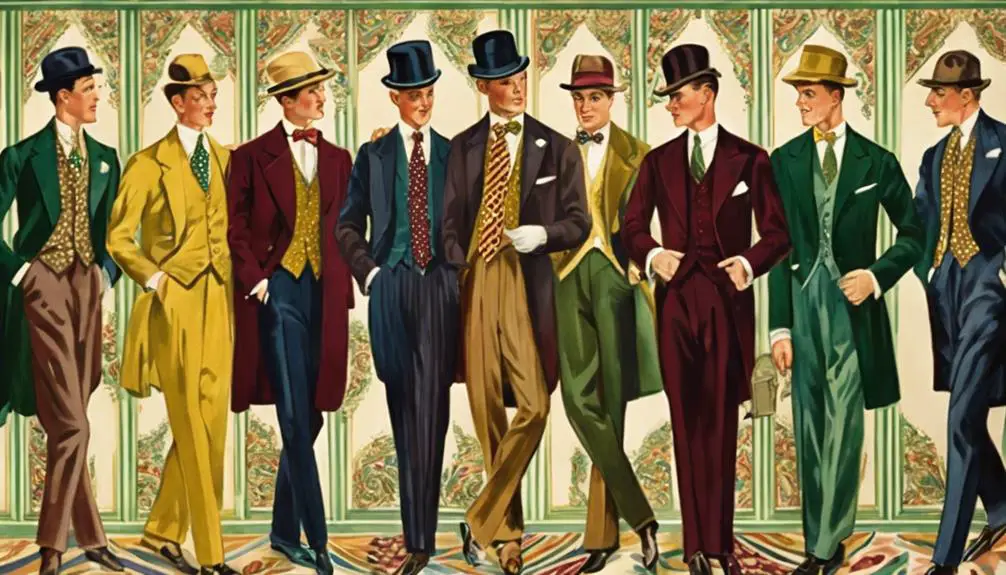
While exploring the vibrant world of tie colors and patterns in the 1920s, you'll discover how these accessories reflected the era's spirit of individuality and flair. Men's ties embraced a rich color palette filled with bright colors like burnt oranges and dark greens, showcasing a bold departure from previous styles. The influence of Art Deco brought striking designs that appealed to the youth, who sought to express their uniqueness.
The patterns of this decade were just as varied, with many men opting for:
- Bold club stripes, which added a touch of sophistication.
- Playful polka dots, making a statement in casual and formal settings.
- Intricate paisley designs featuring gold and silver prints, particularly popular in the early years.
As the decade progressed, polka dots gained prominence, allowing men to showcase their ties with flair. These vibrant colors and patterns weren't just about aesthetics; they represented a cultural shift towards self-expression and confidence. With the introduction of new knot techniques, men could enhance the visual appeal of their ties, making them essential components of a well-dressed gentleman's wardrobe.
Knot Techniques
Mastering knot techniques became an essential skill for gentlemen in the 1920s, elevating the art of wearing a tie to new heights. The choice of knot was crucial, as it not only showcased personal style but also complemented the era's fashion trends. The Four in Hand knot emerged as the most common and versatile option, admired for its simplicity and elegance. In contrast, the Windsor knot gained traction for its bulkiness and structured appearance, ideal for formal occasions and perfectly suited for spread collars.
Different knot techniques worked harmoniously with various collar styles, creating an aesthetic balance that defined men's attire at the time. Your choice of knot often reflected a commitment to contemporary fashion norms, with bolder knots making a striking statement. This evolution in knot techniques indicated a shift toward a more polished and sophisticated approach to men's neckwear.
| Knot Type | Characteristics | Best For |
|---|---|---|
| Four in Hand | Simple, elegant | Everyday wear |
| Windsor | Bulky, structured | Formal occasions |
| Bow Tie | Playful, classic | Special events |
| Pratt | Versatile, neat | Business attire |
| Balthus | Dramatic, wide | Fashion statements |
Purchasing Vintage Ties
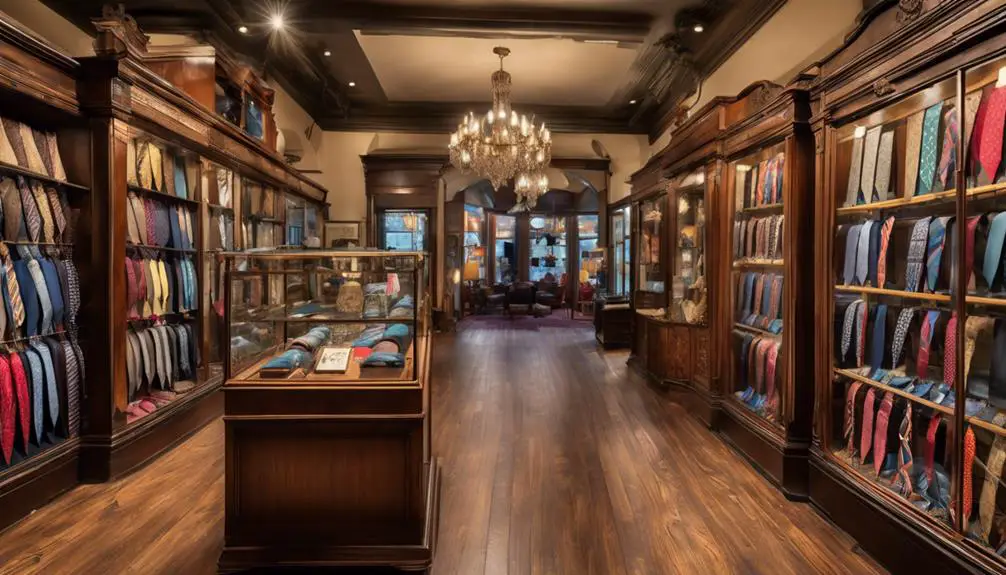
Finding vintage ties from the 1920s can be an exciting journey into the past, especially when you consider the unique craftsmanship and styles of that era. As you explore options, you'll notice a wide range of prices, from $0.99 to $675.00, influenced by style and condition. Dedicated Facebook groups serve as excellent platforms for connecting with fellow enthusiasts, where you can buy, sell, and trade remarkable pieces. Additionally, understanding the historical context of vintage labels can enhance your appreciation of these items, as each label tells a story about its brand and era vintage clothing labels.
When searching for vintage ties, keep these key points in mind:
- Look for intricate designs reflecting the bold colors and Art Deco patterns characteristic of the Jazz Age.
- Pay attention to the condition and fabric quality, as these factors greatly impact both price and longevity.
- Consider listings that offer "or best offer" options, allowing for negotiation on sought-after items.
For instance, you might find a vintage Pendleton wool necktie for $29.99 with free shipping, or a set of formal bow ties from the 1920s priced at $28.99 plus shipping. By utilizing these resources and strategies, you can curate a distinctive collection that captures the essence of 1920s fashion.
Care and Maintenance
Proper care and maintenance of 1920s ties is vital if you want to preserve their unique charm and craftsmanship. To keep your ties looking sharp, consider your storage methods. Hanging or rolling your ties prevents creasing and helps maintain their shape, guaranteeing they remain a stylish accessory for years to come. Regular inspections for wear and tear are essential; catching issues early can keep your ties in excellent condition.
When it comes to cleaning, remember that silk requires gentle handling. For best results, dry cleaning is the safest option, as it preserves the fabric's integrity while removing stains. Additionally, avoid exposing your ties to direct sunlight during storage, as this can lead to fading and diminish their vibrant colors.
If your ties experience damage or need adjustments, don't hesitate to make repairs. This practice not only extends their lifespan but also reflects the era's evolving approach to menswear maintenance. By incorporating these care strategies, you'll guarantee that your 1920s ties remain a symbol of fine craftsmanship and timeless style, ready to elevate any outfit.
Accessories for Ties
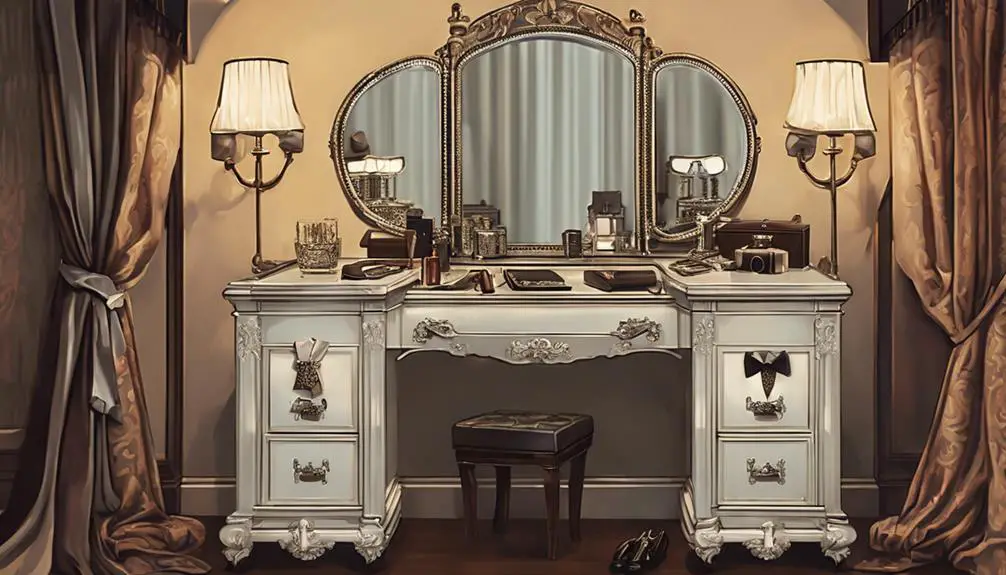
After ensuring your 1920s ties remain in pristine condition, it's time to contemplate how accessories can elevate your overall look. Accessories were more than mere adornments; they were vital in defining the sophistication of your ensemble. With the right pieces, you can seamlessly enhance your neckties and bowties.
Consider these key accessories:
- Tie Clips and Pins: These not only secure your tie but add an elegant touch that speaks to your attention to detail.
- Suspenders: Essential for keeping your trousers in place, suspenders can also create a coordinated look, matching your tie or bowtie for a polished appearance.
- Pocket Watches: A vintage pocket watch can serve both style and practicality, adding authenticity to your formal attire.
In the 1920s, coordinating your accessories was vital. Matching ties with hats and vests created a cohesive aesthetic that showcased your fashion sense. Don't underestimate the power of these accessories; they can transform a simple outfit into a statement of elegance, reflecting the era's emphasis on sophistication and style.
Cultural Significance of Ties
The cultural significance of ties in the 1920s transcended mere fashion; they became symbols of social status and personal identity. As ties evolved into the primary form of men's neckwear, they marked a significant cultural shift. You'd notice how ties—especially those made of men's silk—served as canvases for self-expression, reflecting the era's evolving gender roles and fashion norms.
Fashion magazines of the time extensively showcased various styles, with pattern ties featuring prominently. This was an era influenced by the opulence of the Great Gatsby, where ties became staples in both business and casual attire, signaling sophistication and class across social strata.
Moreover, the Jazz Age played a vital role in shaping tie culture. Hollywood stars popularized vibrant colors and bold patterns, such as polka dots and stripes, encouraging men to experiment with their looks. This shift mirrored changing attitudes toward masculinity, where flamboyance and elegance began to coexist. Ultimately, ties in the 1920s were more than just accessories; they were essential expressions of identity, ambition, and the cultural dynamism of the time.
Frequently Asked Questions
Did Men Wear Bow Ties in the 1920s?
Yes, men did wear bow ties during that era. You'd find them in various bold patterns, reflecting personal style. They became a fashionable choice for formal events, showcasing flair and adapting to evolving fashion trends.
What Was the Tie Knot in the 1920s?
In the 1920s, you'd often choose between the Four in Hand and Windsor knots. The Four in Hand offers casual elegance, while the Windsor provides a formal, bulky look, perfect for upscale events and business settings.
What Was the Width of Ties in the 1920s?
In the 1920s, you'd notice ties evolving from about 2 inches to widths of 3 to 3.5 inches. This shift mirrored fashion trends, emphasizing bold styles and vibrant patterns that defined the decade's aesthetic.
When Did Men Start Wearing Bow Ties?
You'll find men began wearing bow ties in the late 19th century. Their popularity surged through the decades, influenced by fashion trends, social events, and cultural icons, ultimately solidifying their status as a stylish accessory.
